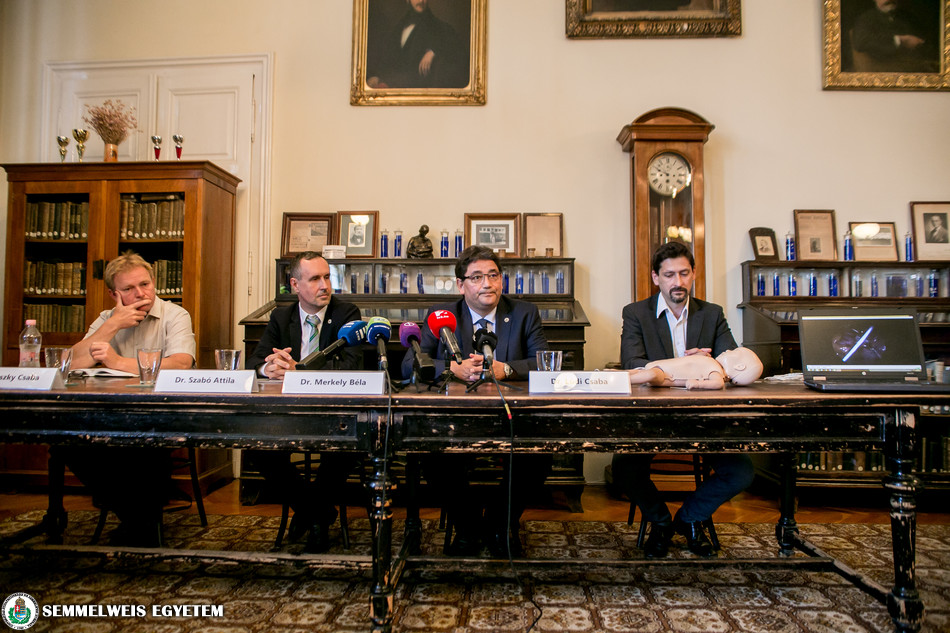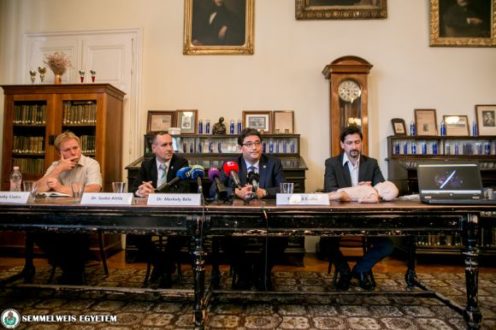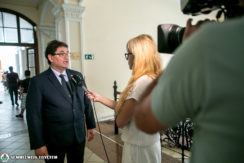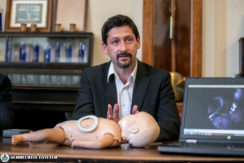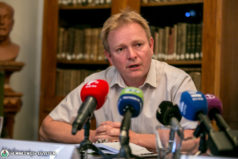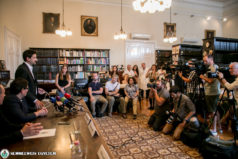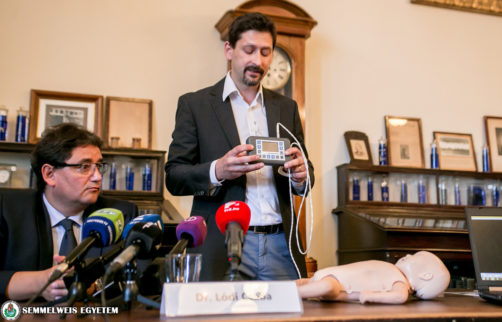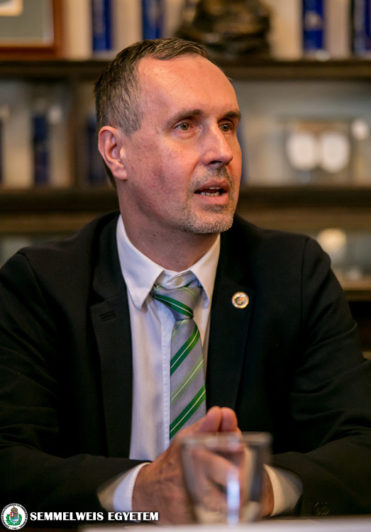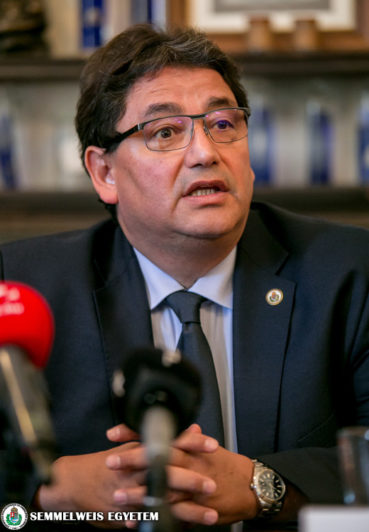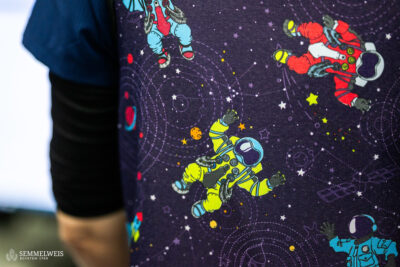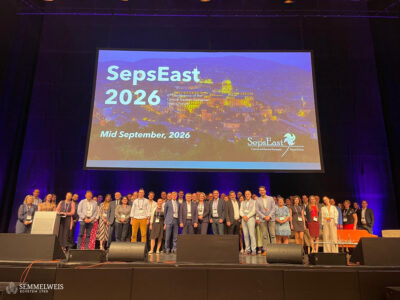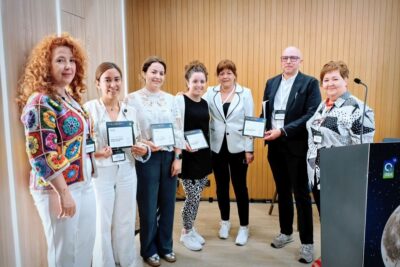The 5-year-old boy, who has undergone the diaphragm pacemaker grafting for the first time in Hungary, needed artificial respiration continuously at night. Dr. Béla Merkely, Rector of Semmelweis University, claimed that the innovative intervention seldom happens in Europe. Dr. Attila Szabó, Director of the 1st Department of Paediatrics, Vice-rector for Clinical Affairs, explained that the young boy is well, his respiration is regular and continuous. As Dr. Csaba Lódi, the leader of the department’s Intensive Care Unit, the boy’s therapist, claimed that the boy suffered from a rare, inborn disease and one of the symptoms is that respiration stops during sleeping, but due to the intervention done by Dr. Attila Kálmán, the young boy breathes without a respiratory machine.
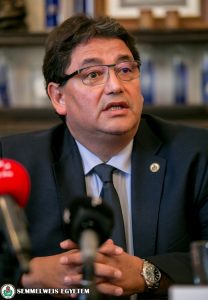 The knowledge used in medicine doubles in every one and a half-two year time, which is a great success and it gives newer and newer chances to help patients – highlighted Dr. Béla Merkely. The rector of the university added that Semmelweis University, as the flagship of medical training, finds innovation and implementing new intervention techniques into practice important. The rector also emphasised that the new intervention method infiltrates into education that leads to another new innovation and finally it improves patient care. Dr. Merkely said that the recently used intervention is a novelty not only in Hungary but also in other countries of Eastern-Central Europe. The rector found it joyful that they could help a child with this intervention. Dr. Merkely also said that applying novelties and innovative solutions have great significance in medical training, which is beneficial not only to the patients but also to the students of the university.
The knowledge used in medicine doubles in every one and a half-two year time, which is a great success and it gives newer and newer chances to help patients – highlighted Dr. Béla Merkely. The rector of the university added that Semmelweis University, as the flagship of medical training, finds innovation and implementing new intervention techniques into practice important. The rector also emphasised that the new intervention method infiltrates into education that leads to another new innovation and finally it improves patient care. Dr. Merkely said that the recently used intervention is a novelty not only in Hungary but also in other countries of Eastern-Central Europe. The rector found it joyful that they could help a child with this intervention. Dr. Merkely also said that applying novelties and innovative solutions have great significance in medical training, which is beneficial not only to the patients but also to the students of the university.
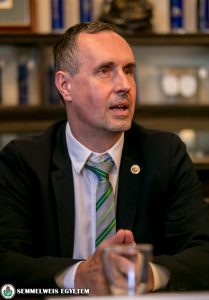 Dr. Attila Szabó, Vice-rector for Clinical Affairs, Director of the 1st Department of Paediatrics, said that the 1st Department of Paediatrics is the oldest paediatric institute in Hungary and the 4th oldest one in Europe that gave place to innovative interventions, researches and the appearance of them in patient care. The Vice-rector added that the department is a front-line fighter for using the latest methods in patients as soon as possible. Dr. Szabó explained that the device was implanted by Dr. Attila Kálmán, Director of the Paediatric Surgery Unit, by a so-called keyhole surgery method. This method is special because in the case of implementing new devices usually open operation technique is used, but Dr. Kálmán was prepared to make the operation with the smallest intervention. Dr. Szabó explained that the child has a rare disease: the respiration center of the central nervous system does not work properly so the boy’s breathing stops during sleeping. The new device regularly and periodically stimulates one of our most important respiratory muscles, the diaphragm, therefore the boy will be able to breathe independently so he will not need a respiratory machine and his quality of life can develop significantly. The director highlighted that they would put their effort into making the most modern diagnostic and therapeutic methods available for the patients.
Dr. Attila Szabó, Vice-rector for Clinical Affairs, Director of the 1st Department of Paediatrics, said that the 1st Department of Paediatrics is the oldest paediatric institute in Hungary and the 4th oldest one in Europe that gave place to innovative interventions, researches and the appearance of them in patient care. The Vice-rector added that the department is a front-line fighter for using the latest methods in patients as soon as possible. Dr. Szabó explained that the device was implanted by Dr. Attila Kálmán, Director of the Paediatric Surgery Unit, by a so-called keyhole surgery method. This method is special because in the case of implementing new devices usually open operation technique is used, but Dr. Kálmán was prepared to make the operation with the smallest intervention. Dr. Szabó explained that the child has a rare disease: the respiration center of the central nervous system does not work properly so the boy’s breathing stops during sleeping. The new device regularly and periodically stimulates one of our most important respiratory muscles, the diaphragm, therefore the boy will be able to breathe independently so he will not need a respiratory machine and his quality of life can develop significantly. The director highlighted that they would put their effort into making the most modern diagnostic and therapeutic methods available for the patients.
Dr. Csaba Lódi, the leader of the department’s Intensive Care Unit, introduced the operating principle of the new device. The components of the device are the stimulating electrode implanted onto the diaphragm nerve, the radio sound receiver put into the tissue under the skin and the external device (signal circuit and antenna).
According to the diaphragm nerve, a bilateral antenna is connected to the external control module and this antenna sends the radio frequency sign through the skin to the receiver, implanted under the skin, and the receiver transforms the signs into electrical impulses and forwards them to the diaphragm nerve. By stimulating the diaphragm nerve, it shrinks and because of the negative pressure in the lung, inspiration happens.
Csaba Hodruszky, another 6-year-old girl’s father explained that at the birth of his daughter it turned out that she did not respire. She has a rare genetic disease, she needs continuous artificial respiration. She could be taken home from the hospital after one year, and she still needs artificial respiration at night. She could go to the kindergarten at the age of four, and an intensive nurse must be there to look after her. She needs to go home after lunch to nap a little. The girl has missed a lot of experiences until now, so they are looking forward to the intervention, so the young girl will be able to breathe independently.
Tímea Kele
Photo: Attila Kovács – Semmelweis University
Translation: Edina Szendreiné Nagy
